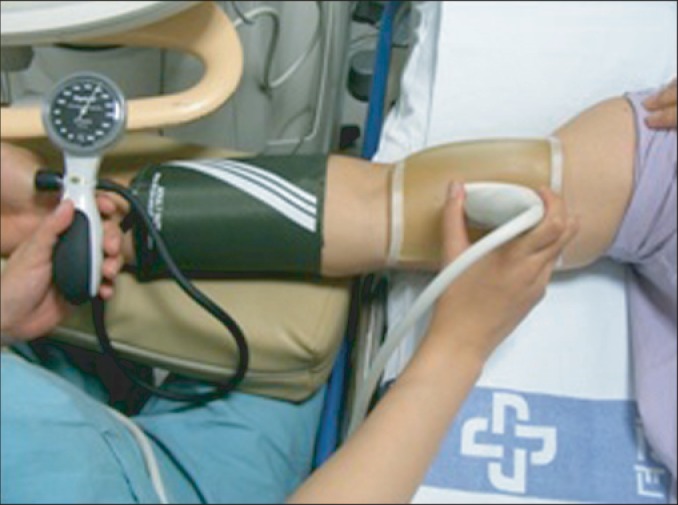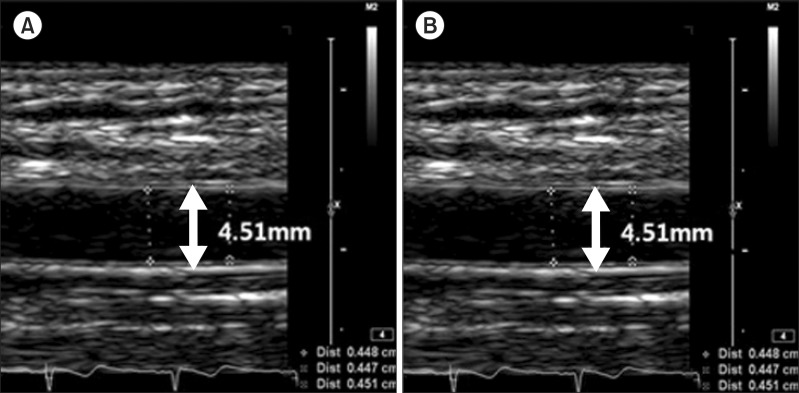Ann Rehabil Med.
2014 Jun;38(3):388-395. 10.5535/arm.2014.38.3.388.
Impact of Aerobic Exercise Training on Endothelial Function in Acute Coronary Syndrome
- Affiliations
-
- 1Department of Rehabilitation Medicine, Inje University Sanggye Paik Hospital, Seoul, Korea. s3034@paik.ac.kr
- 2Department of Rehabilitation Medicine, Inje University Haeundae Paik Hospital, Busan, Korea.
- 3Division of Cardiology, Departments of Internal Medicine, Inje University Sanggye Paik Hospital, Seoul, Korea.
- KMID: 2165758
- DOI: http://doi.org/10.5535/arm.2014.38.3.388
Abstract
OBJECTIVE
To confirm the improvement in arterial endothelial function by aerobic exercise training, flow-mediated dilation (FMD) was tested by ultrasonography.
METHODS
Patients who received percutaneous coronary intervention due to acute coronary syndrome were included. The patients who participated in cardiac rehabilitation (CR) program were categorized as the CR group, and others who did not participate as the control. Both groups underwent initial graded exercise test (GXT) and FMD testing. Subsequently, the CR group performed aerobic exercise training sessions. Patients in control only received advice regarding the exercise methods. After six weeks, both groups received follow-up GXT and FMD testing.
RESULTS
There were 16 patients in each group. There were no significant differences in the general characteristics between the groups. The VO2peak was 28.6+/-4.7 mL/kg/min in the CR group and 31.5+/-7.4 mL/kg/min in the control at first GXT, and was 31.1+/-5.1 ml/kg/min in the CR group and 31.4+/-6.0 ml/kg/min in the control at the follow-up GXT in six weeks. There was a statistically significant improvement in VO2peak only for CR group patients. FMD value was 7.59%+/-1.26% in the CR group, 7.36%+/-1.48% in the control at first and 9.46%+/-1.82% in the CR group, and 8.31%+/-2.04% in the control after six weeks. There was a statistically significant improvement in FMD value in the CR group.
CONCLUSION
According to the results of GXT and FMD testing, six-week exercise-based CR program improved VO2peak and endothelial functions significantly. Thus, exercise-based CR program is necessary in patients with coronary artery disease.
MeSH Terms
Figure
Cited by 1 articles
-
Overview of cardiac rehabilitation
Chul Kim
J Korean Med Assoc. 2016;59(12):938-946. doi: 10.5124/jkma.2016.59.12.938.
Reference
-
1. Leung FP, Yung LM, Laher I, Yao X, Chen ZY, Huang Y. Exercise, vascular wall and cardiovascular diseases: an update (Part 1). Sports Med. 2008; 38:1009–1024. PMID: 19026018.2. Vanhoutte PM, Shimokawa H, Tang EH, Feletou M. Endothelial dysfunction and vascular disease. Acta Physiol (Oxf). 2009; 196:193–222. PMID: 19220204.
Article3. Linke A, Schoene N, Gielen S, Hofer J, Erbs S, Schuler G, et al. Endothelial dysfunction in patients with chronic heart failure: systemic effects of lower-limb exercise training. J Am Coll Cardiol. 2001; 37:392–397. PMID: 11216952.
Article4. Allen JD, Cobb FR, Kraus WE, Gow AJ. Total nitrogen oxide following exercise testing reflects endothelial function and discriminates health status. Free Radic Biol Med. 2006; 41:740–747. PMID: 16895794.
Article5. Verma S, Anderson TJ. Fundamentals of endothelial function for the clinical cardiologist. Circulation. 2002; 105:546–549. PMID: 11827916.
Article6. Furchgott RF, Zawadzki JV. The obligatory role of endothelial cells in the relaxation of arterial smooth muscle by acetylcholine. Nature. 1980; 288:373–376. PMID: 6253831.
Article7. Lüscher TF, Barton M. Biology of the endothelium. Clin Cardiol. 1997; 20(11 Suppl 2):II-3–II-10.
Article8. Ross R. Atherosclerosis: an inflammatory disease. N Engl J Med. 1999; 340:115–126. PMID: 9887164.9. Hambrecht R, Hilbrich L, Erbs S, Gielen S, Fiehn E, Schoene N, et al. Correction of endothelial dysfunction in chronic heart failure: additional effects of exercise training and oral L-arginine supplementation. J Am Coll Cardiol. 2000; 35:706–713. PMID: 10716474.
Article10. Vona M, Rossi A, Capodaglio P, Rizzo S, Servi P, De Marchi M, et al. Impact of physical training and detraining on endothelium-dependent vasodilation in patients with recent acute myocardial infarction. Am Heart J. 2004; 147:1039–1046. PMID: 15199353.
Article11. Farsidfar F, Kasikcioglu E, Oflaz H, Kasikioglu D, Meric M, Umman S. Effect of different intensities of acute exercise on flow-mediated dilatation in patients with coronary heart disease. Int J Cardiol. 2008; 124:372–374. PMID: 17368830.12. Anderson TJ, Gerhard MD, Meredith IT, Charbonneau F, Delagrange D, Creager MA, et al. Systemic nature of endothelial dysfunction in atherosclerosis. Am J Cardiol. 1995; 75:71B–74B. PMID: 7801869.
Article13. Corretti MC, Anderson TJ, Benjamin EJ, Celermajer D, Charbonneau F, Creager MA, et al. Guidelines for the ultrasound assessment of endothelial-dependent flow-mediated vasodilation of the brachial artery: a report of the International Brachial Artery Reactivity Task Force. J Am Coll Cardiol. 2002; 39:257–265. PMID: 11788217.14. Piepoli MF, Davos C, Francis DP, Coats AJ. ExTraMATCH Collaborative. Exercise training meta-analysis of trials in patients with chronic heart failure (ExTraMATCH). BMJ. 2004; 328:189. PMID: 14729656.
Article15. O'Connor GT, Buring JE, Yusuf S, Goldhaber SZ, Olmstead EM, Paffenbarger RS Jr, et al. An overview of randomized trials of rehabilitation with exercise after myocardial infarction. Circulation. 1989; 80:234–244. PMID: 2665973.16. Dugmore LD, Tipson RJ, Phillips MH, Flint EJ, Stentiford NH, Bone MF, et al. Changes in cardiorespiratory fitness, psychological wellbeing, quality of life, and vocational status following a 12 month cardiac exercise rehabilitation programme. Heart. 1999; 81:359–366. PMID: 10092561.17. Witt BJ, Jacobsen SJ, Weston SA, Killian JM, Meverden RA, Allison TG, et al. Cardiac rehabilitation after myocardial infarction in the community. J Am Coll Cardiol. 2004; 44:988–996. PMID: 15337208.
Article18. Cornelissen VA, Onkelinx S, Goetschalckx K, Thomaes T, Janssens S, Fagard R, et al. Exercise-based cardiac rehabilitation improves endothelial function assessed by flow-mediated dilation but not by pulse amplitude tonometry. Eur J Prev Cardiol. 2014; 21:39–48. PMID: 22962311.
Article19. Luk TH, Dai YL, Siu CW, Yiu KH, Chan HT, Lee SW, et al. Effect of exercise training on vascular endothelial function in patients with stable coronary artery disease: a randomized controlled trial. Eur J Prev Cardiol. 2012; 19:830–839. PMID: 21724681.
Article20. Hambrecht R, Adams V, Erbs S, Linke A, Krankel N, Shu Y, et al. Regular physical activity improves endothelial function in patients with coronary artery disease by increasing phosphorylation of endothelial nitric oxide synthase. Circulation. 2003; 107:3152–3158. PMID: 12810615.
Article21. Beckman JA, Creager MA. The nonlipid effects of statins on endothelial function. Trends Cardiovasc Med. 2006; 16:156–162. PMID: 16781949.
Article22. Walsh JH, Bilsborough W, Maiorana A, Best M, O'Driscoll GJ, Taylor RR, et al. Exercise training improves conduit vessel function in patients with coronary artery disease. J Appl Physiol (1985). 2003; 95:20–25. PMID: 12794092.
- Full Text Links
- Actions
-
Cited
- CITED
-
- Close
- Share
- Similar articles
-
- Effects of Aerobic Exercise vs. Resistance Training on Endothelial Function in Women with Type 2 Diabetes Mellitus
- The Effects of Aerobic/Resistance Exercise on Body Fat Mass, Muscle Strength and Endothelial Function in Korean Type 2 Diabetes mellitus Patients
- Synergistic effects of drug and aerobic exercise on endothelial function and epicardial fat thickness in patients with hypertension and dyslipidemia
- The Effects of Long-Term Training of Aerobic Exercise on Some Risk Factors of Cardiovascular Disease
- Effects of Aerobic Exercise Training and Natural Fermented Vinegar on Body Composition and Cardiopulmonary Function in Middle Aged Women



